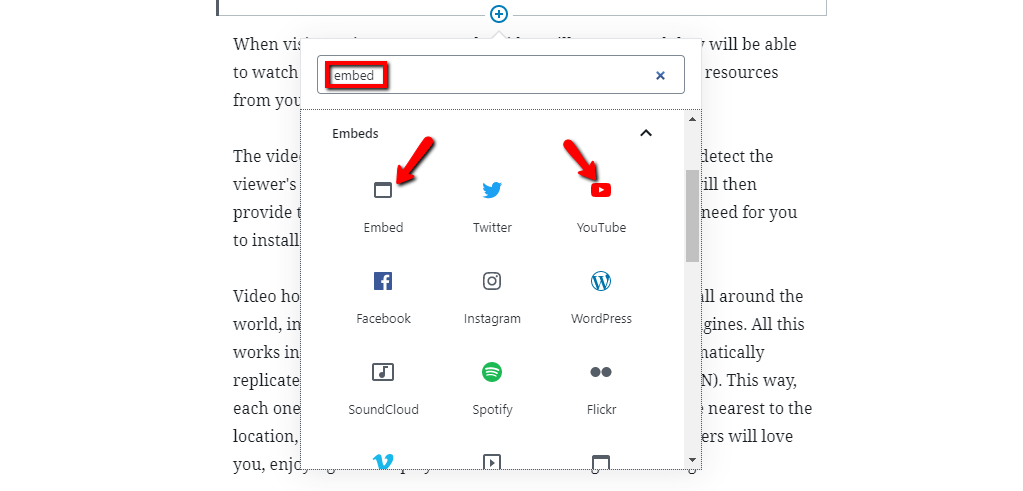
Top 8 Reasons to Avoid Hosting Your Own Videos
The presence of media files (images, audio, and video) is what makes the web rich. When you add relevant and well-done videos to your WordPress site, you are certainly improving the quality of your overall content. Currently, people are getting more and more into watching videos, instead of reading a text. This shift is mostly due to the users being on mobile devices most of the time. So, you can be sure that videos will increase the chances for your visitors to react to your content, be it in the form of comments, subscriptions, or Social media shares.
In this post, we will share exactly why you should implement embedding, instead of using your own WordPress site to host videos. We are going to cover:
Self Hosting Videos vs. Embedding Videos
Before we go into the details about why you should never upload videos directly to your WordPress site, let’s go over the differences between uploading and embedding a video. This way, we will make sure everyone understands the real importance of the matter.
Embedding a video is actually the recommended method to proceed. When embedding, you are essentially using a third-party website like YouTube and Vimeo. You upload your videos there, copy the path to them, and then paste the video path to your WordPress site. The effect is the same as if you have uploaded it directly, except that you are not using the space provided by your web host, which is great. Embedding videos in WordPress is a relatively quick and easy process.
Keep in mind that the embed method is not available only for videos. You can do the same with other files, such as documents, social media posts, audio files, maps, tweets, content from other sites or your own, etc.
Reasons Against Self-hosting Videos
Even if your hosting plan offers a large amount of monthly bandwidth, you should still use a third-party video hosting and avoid unnecessary bandwidth usage. It’s not a good idea to host your videos on your own website, because having large files that are often viewed (downloaded) by lots of people at the same time can cause a lot of stress on a shared hosting server. That has a negative impact on you and all other users on that specific server.
Higher Bandwidth Utilization
Bandwidth is the amount of data available (per month) for transfer from and to your hosting account. Every time someone downloads a 40 KB file from your website, they use 40 KB of bandwidth from your account. The same rule applies to videos that you host on your site.
Too many requests on the server for a single large file could potentially result in exceeding the limits of the web hosting server and cause resource issues on the server overall. This may lead to your site getting temporarily suspended until the issue is resolved. Keep in mind that most web hosting services do not allow one site to affect all other sites sharing the same server.
File Size Limits and Storage Space
If you upload large video files to a shared web hosting server frequently, you will eventually exceed the amount of storage that you have with your hosting plan. That would be the case, especially if you back up your site on a regular basis. Additionally, to the amount of space backups will occupy, they will also start taking significantly longer to execute. In general, more data requires more disk space, which takes more time to backup.
Inode Limits
An inode is a data structure that is used to keep information about a file on a hosting account. The inode number is an indication of the number of files and folders you have, including everything on your hosting account (emails, files, folders, and everything else stored on the server). Just like with bandwidth, hosting your video files directly on your web server could easily result in exceeding your inode limit.
Unlike images or audio files, video files can be very large in size. An HD video could easily be as large as 200 MB or even more – unlike images or audio files, which are generally measured by kilobytes, which are mere in comparison.
Slow Loading Video or Unexpected Pauses When Streaming
It’s not unusual for shared server users to assume that only the server takes the load and all the damage. However, that’s not how things work. Oftentimes, when you upload the video directly to your WordPress site, it will lag while streaming. That leads to frustrated viewers and bad ratings.
The lagging or freezing issue can escalate even further with a higher number of users on the shared server uploading their video files for direct streaming. Another reason against self-hosting your videos is that there could be visitors with slow internet or lousy connection to the server where the video is being hosted.
No Standard Video File Format Available
Currently, there are no standard video formats in use by all browsers. This is due to the current HTML5 specification. Each of the major browsers is using a different video format, and thus video files need to be converted into various video file formats. All that means that you will need to have multiple videos to upload if you want to meet the requirements for all browsers and if you want all your visitors to have a pleasant experience when coming to your WordPress website.
Need for Generating Different Sizes/Bitrates
Most people view videos on their laptops or desktops, but that doesn’t mean nobody uses their mobile device for that. With that said, you will not aim for serving big 1080 HD files to mobile devices and 480p videos to laptops and desktops with fast connections. So, with self-hosting, you will have to generate every video in different sizes, especially if you want an optimal user experience (UX).
If your internet speed suddenly drops while viewing YouTube, Vimeo, Dailymotion, or another major video streaming site, the video will continue playing but will go to worse quality. This is to prevent buffering, and it’s one of the main reasons to use a 3rd party service for your video hosting. Such services are specialized and will handle almost everything for you quickly and with ease.
Varying Quality Across Browsers
We have already mentioned that you will have to create more than just one file for the same video. For that, you will need an application. There are dozens of them on the Internet, and the choice is entirely up to you. However, it could turn out that you need more than one application, especially if you want to convert your video into all the format types (.mp4, .OGG, .mkv, .avi, etc.).
Sadly, each app handles conversions with some slight differences. That often results in varying quality between all versions of your video. It may look great as an OGG file in Mozilla Firefox, but a bit lower in quality when viewed as an mp4 in Internet Explorer.
Additionally, different browsers handle playback in a different way, meaning the same video could work great in one browser but be buggy in another. You could spend hours experimenting with your videos and still not get a 100% match.
Potential Piracy
If you host your own videos, the file paths are often exposed in the source code, making them easy to be snatched. Anyone can simply copy the URL of the video’s location, download the file, and then upload it on the Internet, claiming it’s their own. It would be a much better choice to use embedding instead of self-hosting. That’s to protect your files and your WordPress site.
WordPress Video Plugins
Never forget about the impact a video can have on your visitors. Having videos shared/embedded on your blog or page can be crucial, especially since more and more people use YouTube and Vimeo as search engines. Having videos or even video galleries will make your site much more alive and appealing, sending your message louder and clearer. We have already shared our post on how to embed videos, but there are many more things you can do, such as video playlists, video sliders, or video backgrounds.
The number of WordPress plugins grows with each day, getting better and better, and making your job as a site owner easier and easier.
There are lots of WordPress video plugins, but only some are of high-quality. We will share those below, along with a short description for each one of them:
- WP Video Lightbox (active installations: 70,000+) – A mobile-friendly lightbox plugin that allows you the embedding and displaying of YouTube/Vimeo/HTML5 in a responsive modal popup with autoplay, deep linking and navigation support.
- ARVE Advanced Responsive Video Embedder (active installations: 60,000+) – A responsive, easy-to-use, and SEO-friendly WordPress video plugin for handling video (HTML5, YouTube, Vimeo, etc.) embeds on your WordPress website.
- Easy Video Player (active installations: 40,000+) – A WordPress video plugin designed to be user-friendly. It can showcase self-hosted videos or videos linked to YouTube, Vimeo, DailyMotion, etc.
- Video Embed & Thumbnail Generator (active installations: 30,000+) – A responsive WordPress video embed plugin that makes it much easier when you have user-uploaded videos. The design of this HTML5 player is responsive, has auto-resizing, cross-browser compatibility, and thumbnail support.
- Featured Video Plus (active installations: 30,000+) – A WordPress video plugin that lets you set featured videos for your post (instead of images). Featured Video Plus supports HTML5, YouTube, Vimeo, DailyMotion, etc.
The Best Way to Add a Video to Your Site
First things first—you need to upload your video to a video hosting service like YouTube, Vimeo, or Dailymotion. Once the video has been uploaded, copy the URL to your video. Return to your WordPress site and paste the URL into your post or page where you want the video to appear. Don’t forget that you can simply use the embed block in the Block Editor:

When visitors view your page, the video will appear, and they will be able to watch it from the third-party video host, without using any resources from your web hosting server.
The video player that you have embedded will automatically detect the viewer’s device, browser, and connection speed. The player will then provide the appropriate version of the video file, without the need for you to install anything or write some tricky code.
Video hosts like YouTube and Vimeo have massive networks all around the world, in addition to being part of the most popular search engines. All this works in your favor. After you upload a video, it will be automatically replicated on each server on its content delivery network (CDN). This way, each one of your visitors will be able to get the video from the nearest to the location, making the connection as fast as possible. Your viewers will love you, enjoying smooth playback without freezing or buffering.
Final Thoughts
So, now that you have enough information, you know that there is no reason not to use a third party video host for your video content. Embedding is not only the best option when it comes to resources, but also saves you time and ensures optimal user experience.
When talking about optimization, we also have a blog post about image optimization on WordPress, feel free to check it out.
As always, if you have any questions or something to add, feel free to use the comment section. We are always happy to answer questions, or even just converse.

The latest tips and news from the industry straight to your inbox!
Join 30,000+ subscribers for exclusive access to our monthly newsletter with insider cloud, hosting and WordPress tips!



No Comments